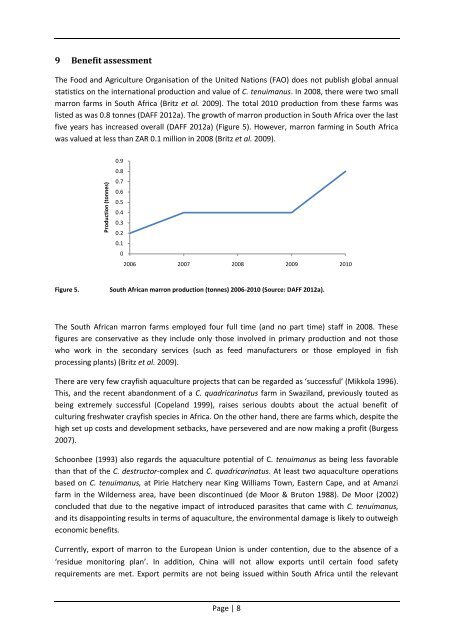Marron, freshwater crayfish Cherax tenuimanus - Department of ...
Marron, freshwater crayfish Cherax tenuimanus - Department of ...
Marron, freshwater crayfish Cherax tenuimanus - Department of ...
You also want an ePaper? Increase the reach of your titles
YUMPU automatically turns print PDFs into web optimized ePapers that Google loves.
Production (tonnes)<br />
9 Benefit assessment<br />
The Food and Agriculture Organisation <strong>of</strong> the United Nations (FAO) does not publish global annual<br />
statistics on the international production and value <strong>of</strong> C. <strong>tenuimanus</strong>. In 2008, there were two small<br />
marron farms in South Africa (Britz et al. 2009). The total 2010 production from these farms was<br />
listed as was 0.8 tonnes (DAFF 2012a). The growth <strong>of</strong> marron production in South Africa over the last<br />
five years has increased overall (DAFF 2012a) (Figure 5). However, marron farming in South Africa<br />
was valued at less than ZAR 0.1 million in 2008 (Britz et al. 2009).<br />
0.9<br />
0.8<br />
0.7<br />
0.6<br />
0.5<br />
0.4<br />
0.3<br />
0.2<br />
0.1<br />
0<br />
2006 2007 2008 2009 2010<br />
Figure 5.<br />
South African marron production (tonnes) 2006-2010 (Source: DAFF 2012a).<br />
The South African marron farms employed four full time (and no part time) staff in 2008. These<br />
figures are conservative as they include only those involved in primary production and not those<br />
who work in the secondary services (such as feed manufacturers or those employed in fish<br />
processing plants) (Britz et al. 2009).<br />
There are very few <strong>crayfish</strong> aquaculture projects that can be regarded as ‘successful’ (Mikkola 1996).<br />
This, and the recent abandonment <strong>of</strong> a C. quadricarinatus farm in Swaziland, previously touted as<br />
being extremely successful (Copeland 1999), raises serious doubts about the actual benefit <strong>of</strong><br />
culturing <strong>freshwater</strong> <strong>crayfish</strong> species in Africa. On the other hand, there are farms which, despite the<br />
high set up costs and development setbacks, have persevered and are now making a pr<strong>of</strong>it (Burgess<br />
2007).<br />
Schoonbee (1993) also regards the aquaculture potential <strong>of</strong> C. <strong>tenuimanus</strong> as being less favorable<br />
than that <strong>of</strong> the C. destructor-complex and C. quadricarinatus. At least two aquaculture operations<br />
based on C. <strong>tenuimanus</strong>, at Pirie Hatchery near King Williams Town, Eastern Cape, and at Amanzi<br />
farm in the Wilderness area, have been discontinued (de Moor & Bruton 1988). De Moor (2002)<br />
concluded that due to the negative impact <strong>of</strong> introduced parasites that came with C. <strong>tenuimanus</strong>,<br />
and its disappointing results in terms <strong>of</strong> aquaculture, the environmental damage is likely to outweigh<br />
economic benefits.<br />
Currently, export <strong>of</strong> marron to the European Union is under contention, due to the absence <strong>of</strong> a<br />
‘residue monitoring plan’. In addition, China will not allow exports until certain food safety<br />
requirements are met. Export permits are not being issued within South Africa until the relevant<br />
Page | 8
















